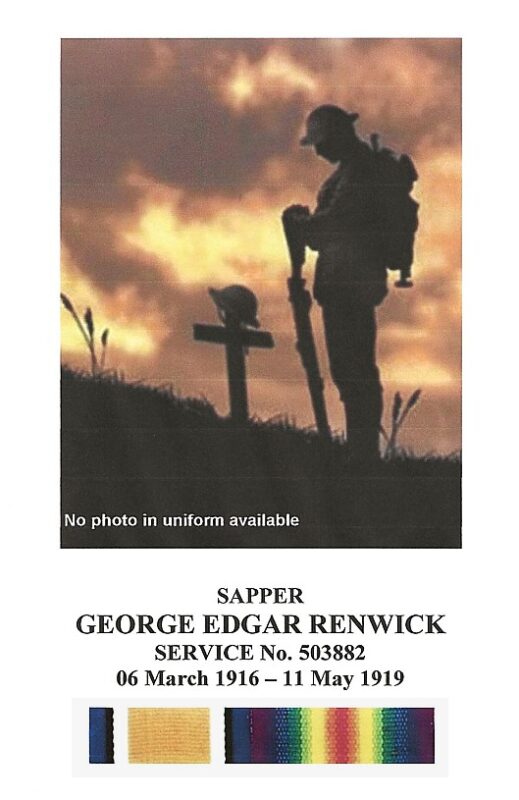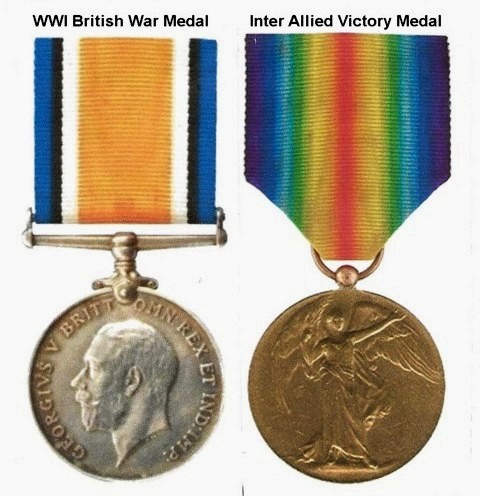
MILITARY HISTORY
SAPPER GEORGE EDGAR RENWICK –No. 503882 – Active Service (World War I)
On March 6th, 1916, George Edgar Renwick completed the Attestation Paper for the Canadian Active Service Force (CASF) in Ottawa Ontario.
He was 19 years old when, as an unmarried man, he enlisted for the duration of the War. George was born in Dromore, Ontario, and gave his birthdate as February 17th, 1897. He listed his present address as Dromore, Ontario. George indicated that he had no previous Military experience and he had not served in an Active Formation or Unit of The Canadian Army.
George indicated he had previously worked as a student. He was described as standing 5 feet 7 inches with a medium complexion and blue eyes and brown hair. He was assigned to the Signal Training Depot and trained in Ottawa.
On June 3rd, 1916, he was assigned to the 4th Divisional training unit sent to England and trained in Shorncliffe, and taken on strength to the signal pool in France on May 30th, 1917.
Sapper Renwick served in France and Belgium throughout the war.
| During the First World War being a signaller usually meant you were close to the frontline troops, providing signals communications back to your Company and Battalion H.Q. Wired telephones were used where possible, but this involved laying landlines which was a hazardous job due to enemy shelling. At the start of WWI flags were also used for signaling but this practice was little used as the war progressed. Where it was not possible to lay landlines then many forms of visual signaling were used which made use of light either from sunlight (use of mirrors) in the daytime or lamps at night. Messages were sent in morse code one man operating the signaling device and one man using a telescope (where distances were great) to read the message sent back. Signallers were also used in forward positions to assist the artillery and provide information on their enemy targets. In these positions, often isolated, the signaller became vulnerable to enemy shelling and attack, and many signallers lost their lives. The standard field telephone used with landlines consisted of a wooden box containing two dry cells, a magneto generator, polarised bell, induction coil testing plug, and a “Hand Telephone C Mk.1.” Towards the end of 1916 these would have been replaced by the Fuller phone and by 1918 many Divisions adopted them in their forward positions. |
Sapper Renwick returned to England March 30th, 1919. Sailed to Canada on May 11th, 1919.and was discharged.
Sapper Renwick had served 1 year in England and 2 years in France and Belgium. He was eligible for the Volunteer Service medal, British War Medal (England and France). He returned to Dromore and later settled in Lakefield, Ontario. He died on December 14th, 1950.
An excerpt from an article in McLean’s magazine by Barbara Amiel, September 1996:
The military is the single calling in the world with job specifications that include a commitment to die for your nation. What could be more honorable

PERSONAL HISTORY
GEORGE EDGAR RENWICK
George Edgar Renwick was born in Dromore, Grey County, Ontario on February 17, 1897, the son of Jane Hastie and Robert Renwick. He received his early education in Durham and Mount Forest. He has five siblings – three brothers and two sisters. As a 19-year-old teenager, George went to Ottawa and enlisted to serve his King and Country. He returned home in May 1919. George continued his education at the University of Toronto graduating in dentistry in 1922. Soon after graduation, George came to Lakefield and set up his dental practice in his home at 58 Bridge Street in Lakefield.
On June 27, 1925, George married Lakefield girl, Mary “Edna” Braden, daughter of Willamina “Mina” Irwin and Thompson Braden, in Lakefield. They had a daughter, Mary Alyce. Dr. Renwick was involved in his community as a past master of the Clementi Lodge AF & AM, and a charter member of the Golden Dawn Rebekah Lodge. He was a member of the Lakefield United Church. Dr. Renwick practiced dentistry from his home for 28 years, right up until his untimely death on December 14, 1950. His wife Edna passed away on April 13, 1991; both are buried in Lakefield Cemetery.